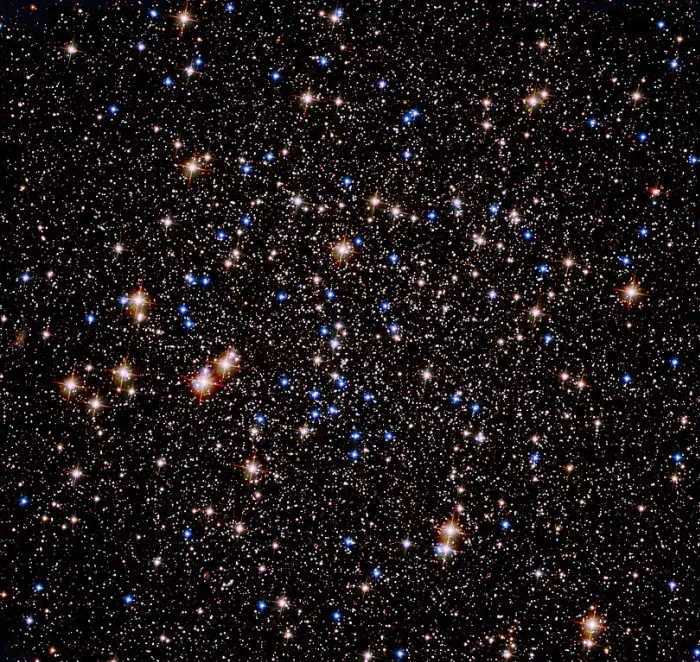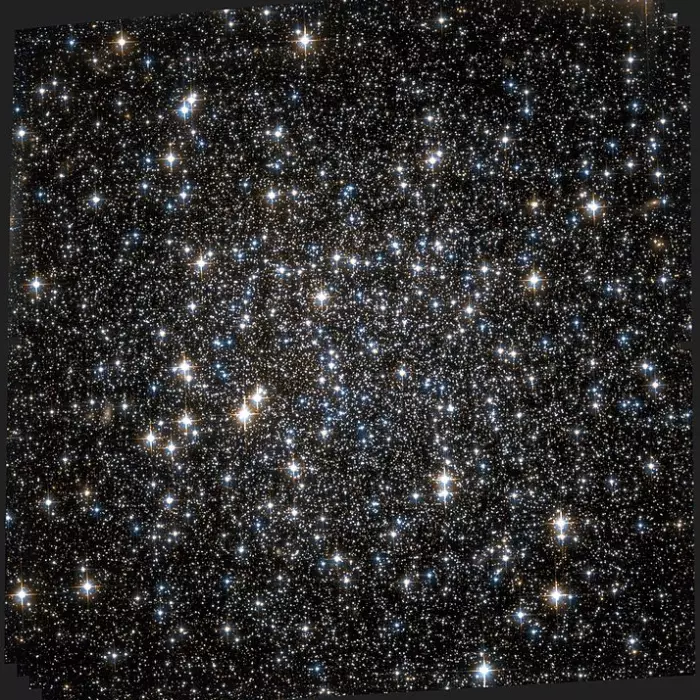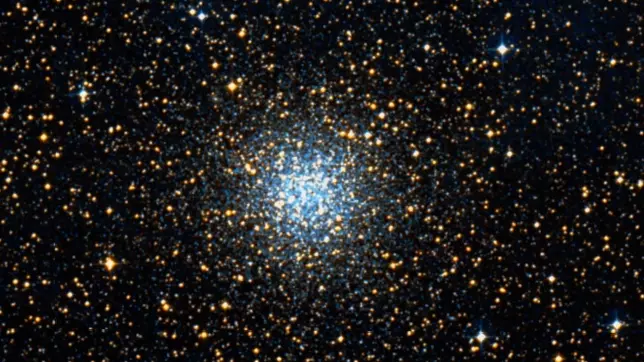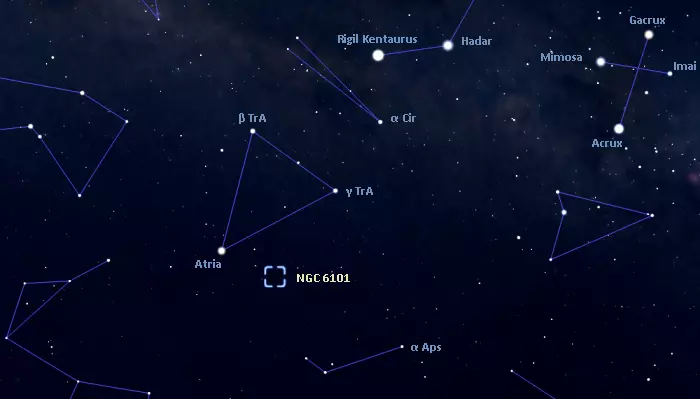Globular Cluster in Apus – Constellation Guide (original) (raw)
NGC 6101 is a globular cluster located approximately 47,600 light-years away in the southern constellation Apus. With an apparent magnitude of 9, it is visible in amateur telescopes. The cluster is catalogued as Caldwell 107 in the Caldwell catalogue of deep sky objects that can be observed in small and medium-sized telescopes.
NGC 6101 is a loosely concentrated cluster with the Shapley-Sawyer Concentration Class X (ten on a scale of one to twelve). Individual stars in the cluster can be resolved in 8-inch and larger telescopes. None of them are brighter than 14th magnitude.
Globular clusters are among the oldest objects in their galaxies, but their origin is still unclear. Some are believed to be remnants of small galaxies devoured by their larger neighbours. The stars in these clusters are metal-poor, which indicates that they are very old.

In the past, astronomers thought globular star clusters were made up of stars that have similar ages and similar chemical abundances. However, recent studies suggest that it might not be that simple. It seems as though many globular clusters contain stars with different chemical abundances, suggesting that they host multiple populations of stars born at different times. This image of the globular cluster Caldwell 107, or NGC 6101, combines observations taken in visible, infrared, and ultraviolet light by Hubble’s Wide Field Camera 3 and its Advanced Camera for Surveys. The stars in Caldwell 107 are more loosely packed than those in other globular clusters, which usually have dense, compact cores. Astronomers observed Caldwell 107 with Hubble to study and characterize the multiple populations within the cluster. Image credit: NASA, ESA, G. Piotto (Università degli Studi di Padova), and A. Sarajedini (Florida Atlantic University); processing: Gladys Kober (NASA/Catholic University of America)
NGC 6101 was discovered by Scottish astronomer James Dunlop on June 1, 1826. Dunlop observed the cluster from Australia and catalogued it as Dun 68. English astronomer John Herschel saw it from South Africa in the 1830s and described it as faint, large and only slightly brighter in the centre.
NGC 6101 lies about 36,500 light-years from the Galactic Centre. A 2010 study classified it as an Oosterhoff type II cluster, with very weak lines of metallic elements and a slightly longer period of RR Lyrae variable stars.
A 2016 study suggested that the cluster hosted several hundreds of stellar-mass black holes. The study was conducted by a team of astronomers at the University of Surrey, UK, who used advanced computer simulations to try to explain the absence of mass segregation in the cluster and to predict where the black holes may be hiding.

Hubble image of globular cluster NGC 6101, credit: NASA and ESA (the Hubble Space Telescope)
Mass segregation is a process that occurs in globular clusters through which stars are sorted according to their masses. Due to gravitational pull, the heavy stars slow down and move to the cluster’s core, while lighter stars move faster and migrate to the periphery. The first direct evidence of mass segregation was based on seven-year observations of the globular cluster 47 Tucanae with the Hubble Space Telescope (HST) in the early 2000s.
NGC 6101 has an unusual structure, with very few observable stars near its centre. The 2016 study explained this with the presence of black holes. The scientists used computer simulations to recreate the behaviour of every individual star and black hole in the cluster in order to reveal how the cluster has evolved over billions of years. The simulations showed the effects of a sizeable population of black holes on the visible stars in the cluster. The study was published in the Monthly Notices of the Royal Astronomical Society.
Black holes form in the gravitational collapse of massive stars that end their lives in supernova events. Supernovae were previously believed to eject black holes from their birth sites. However, the study suggested that they may not expel them from clusters. While black holes cannot be seen even with the largest of telescopes because their gravity is so strong that nothing, including photons, can escape them, the gravitational effects of black holes on their surroundings can be observed for clues to their whereabouts.

NGC 6101, image: Wikisky
Location
The globular cluster NGC 6101 lies in the constellation Apus (Bird of Paradise) in the far southern sky. At declination 72° S, it never rises for observers north of the latitude 18° N. For northern observers near the equator, it never appears very high above the horizon. Southern observers can see the cluster throughout the year because it lies not far from the south celestial pole.
NGC 6101 appears near the border with Triangulum Australe, in the same area of the sky as the bright Atria, the brightest star of the Southern Triangle. Atria forms a conspicuous triangle with Beta and Gamma Trianguli Australis and lies in the same region as the Southern Pointers, Alpha and Beta Centauri (Rigil Kentaurus and Hadar), and the Southern Cross. The cluster appears about 4 degrees southwest of Atria and seven degrees north of the fainter Gamma Apodis, along the imaginary line extended from Hadar through Gamma Trianguli Australis.

The location of NGC 6101, image: Stellarium
The best time of the year to observe NGC 6101 and other deep sky objects in Apus is during the month of July, when the constellation is higher above the horizon in the evening. The entire constellation is visible from locations south of the latitude 5° N.
NGC 6101
| Constellation | Apus |
|---|---|
| Right ascension | 16h 25m 48.12s |
| Declination | –72° 12′ 07.9″ |
| Class | X |
| Apparent magnitude | 9 |
| Apparent size | 10.7′ |
| Distance | 47,600 light-years (14,594 parsecs) |
| Age | 12.54 billion years |
| Metallicity [Fe/H] | –1.76 dex |
| Names and designations | NGC 6101, Caldwell 107, C 1620-720, GCl 40, Dun 68, ESO 69-SC4 |